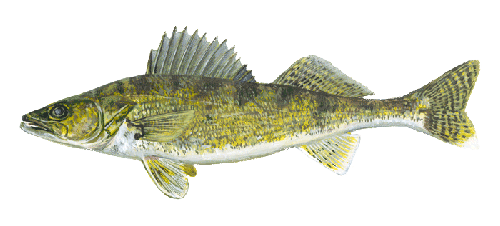
Scientific name:
Sander vitreus (Sander refers to the German common name of the European relative) and vitreus means "glassy", referring to the large eye.
Identification:
Dorsal region of head and back brown, olive, to brassy yellow; sides paler; ventral head and belly yel- low to white. Sides and back variously speckled with dusky spots; in younger fish, vague dusky bands (about 9) across back and down sides. Eyes silvery in life; a reflecting layer (tapetum lucidum) causes glow- ing in dark. Membranes on the spiny dorsal fin diffusely pigmented, no definite horizontal rows of spots; last few membranes black. Second dorsal and caudal fins with dark spots in regular rows; ventral lobe of caudal fin often white-tipped. Pectoral fins pigmented with dark blotch at base; pelvics and anal largely clear.
Distribution:
It is believed that the walleye was originally confined to the larger lakes and waterways in Wisconsin. The extensive stocking of walleye fry and fingerlings that occurred early in many Wisconsin waters partly obscured the original distribution of the species. Today the walleye is present throughout Wisconsin.
Spawning:
The spawning migration of walleye begins soon after the ice goes out, at water temperatures of 38 - 44º F. Spawning in Wisconsin generally occurs between mid-April and early May, although it may extend from the beginning of April to the middle of May. Walleye spawning ordinarily reaches a peak when water temperatures are 42 - 50º F. The walleye is not a territorial fish at spawning time; they usually broadcast their eggs and exercise no parental care.
Angling:
The walleye is one of the most highly prized game fishes in Wisconsin. Thousands are caught each year during their spring spawning runs. Walleyes are primarily minnow feeders, but leeches, small bullheads, nightcrawlers, and various small plugs are favorite baits. In clear waters, walleyes usually stay in deeper areas during the day, moving into the shallows at night. In more turbid waters, they can be caught throughout the day. The large, unusual eyes of the walleye are designed to help them easily find their prey.